Moments before Jean “Jeanie” Diaz was hit and killed by the driver of a car while waiting for the bus on Southeast Cesar E Chavez Blvd and Taylor on Saturday evening, she was on a sidewalk, in what many people assume is a safe area. At the same time, Kevin Scott, who police have charged with drunk driving and manslaughter, swerved and sped toward her in his Infiniti FX 35 SUV.
On Saturday the scene was littered with broken car parts and other debris after Scott and his car jumped the curb, slammed into a dirt retaining wall and the bus stop, and then came to rest upside-down in the street. Today there are paint marks in the road from the police investigation and a growing memorial of flowers, candles, photos, and signs.
“Drunk speeding killed our beloved librarian,” read one of them. “Improve safety for this bus stop and pedestrians!!” read another, with its words surrounded by a rainbow-colored heart.
Since this collision, I’ve heard from several readers who took their kids to storytime with “Ms. Diaz” at Belmont Library. One of them had just been given a summer reading award from Diaz hours before she was killed.
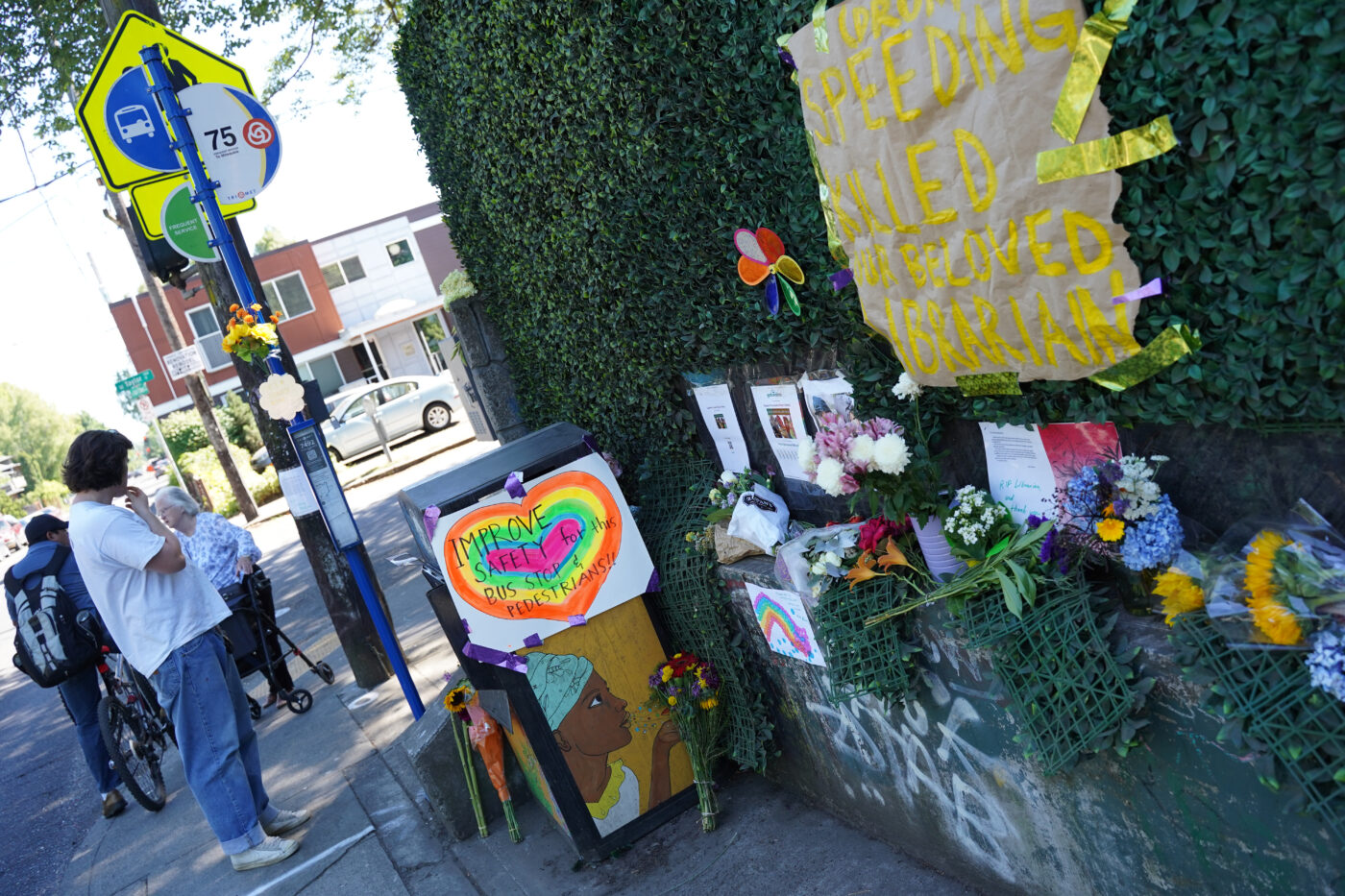



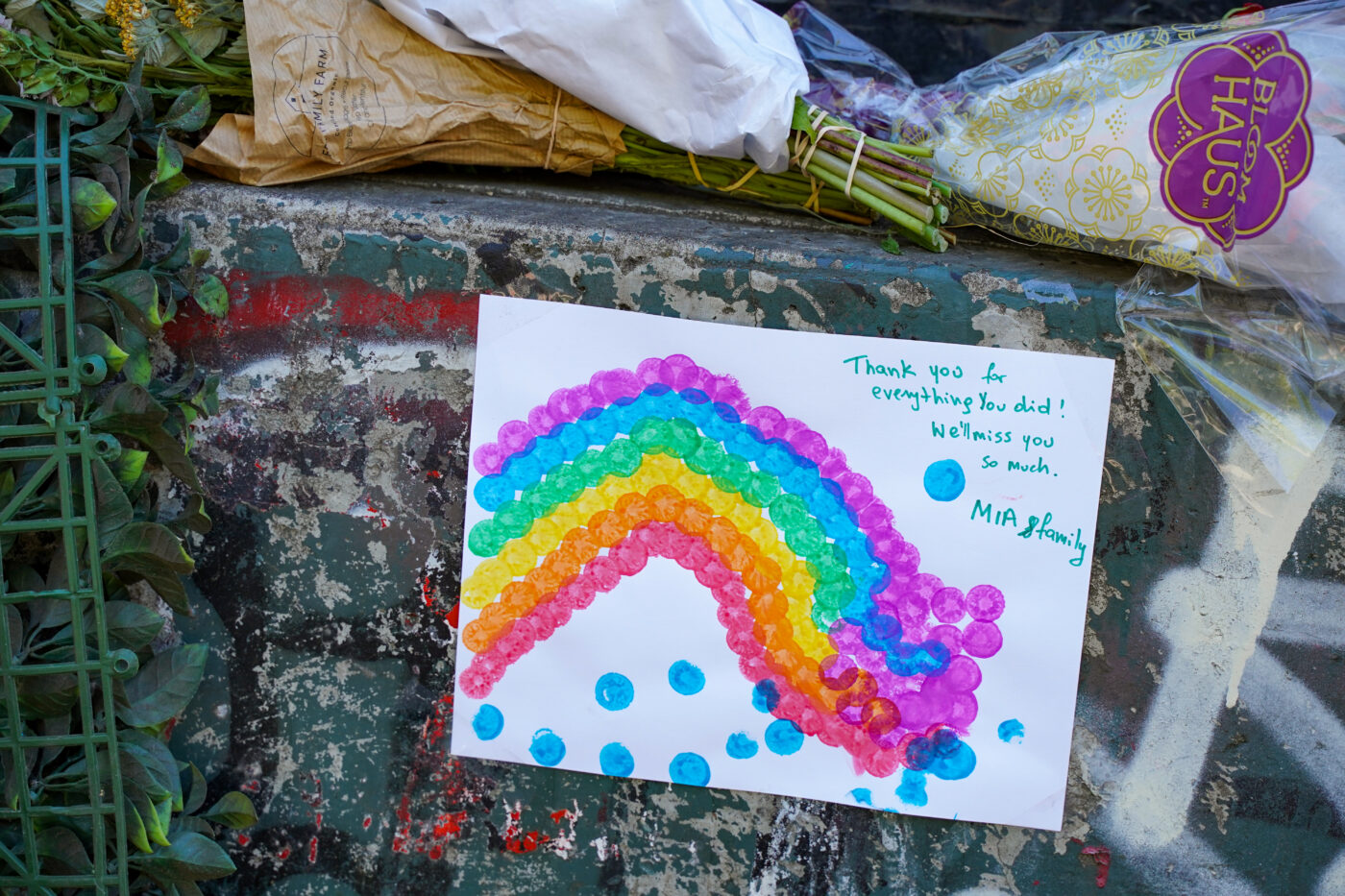
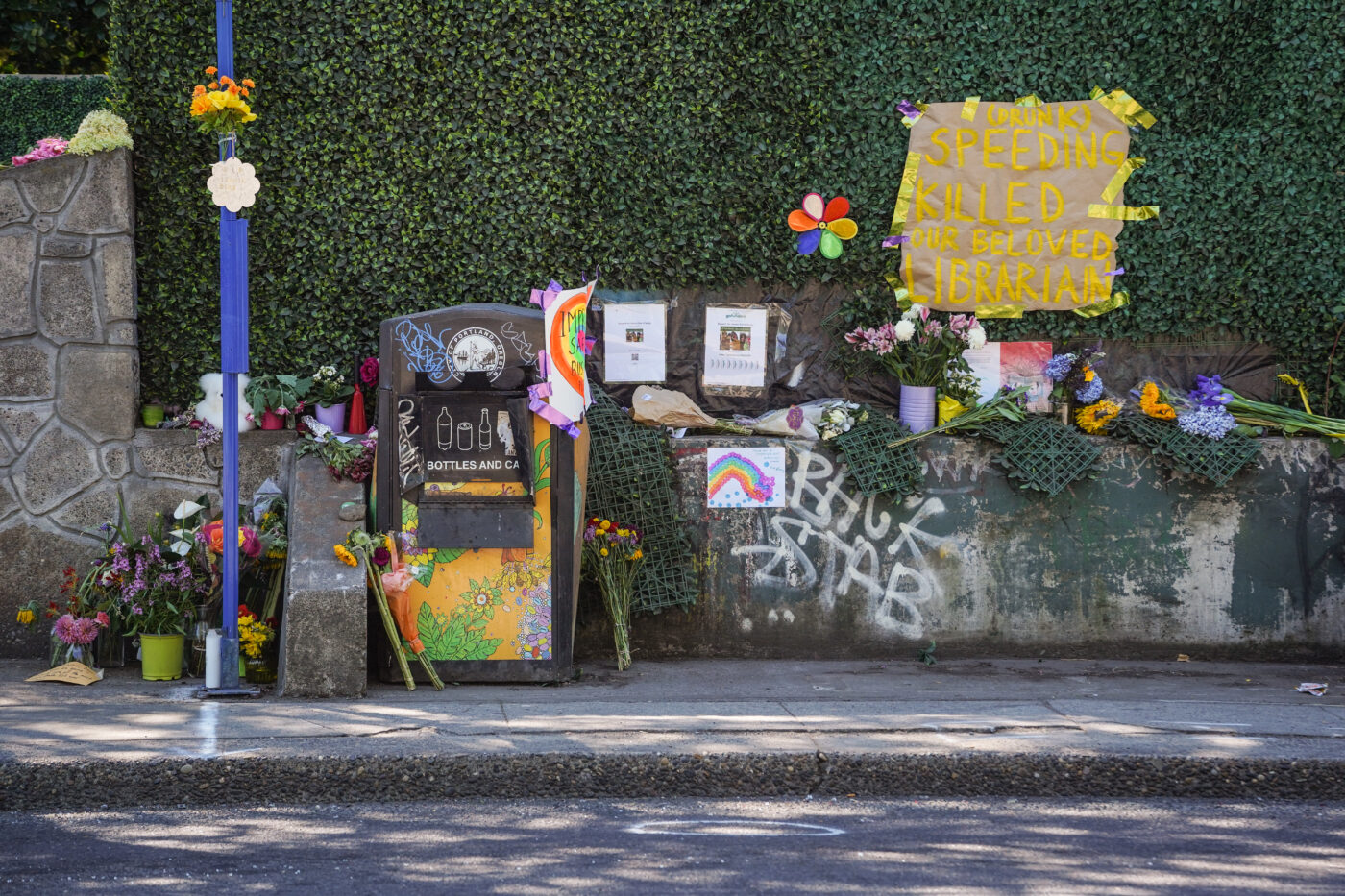
I spent more than an hour at the scene Tuesday afternoon and watched numerous people walk and bike by. One older woman I talked to said she raised two kids a few blocks away. “When they were little we said if they are ever caught bicycling near 39th [now Cesar Chavez], we’ll take their bikes away for two months. It’s just so dangerous here.”
As a steady stream of bicycle riders crossed on the SE Taylor neighborhood greenway, people walked back and forth on the very narrow sidewalk Diaz was likely standing on before she was killed.
Cesar Chavez Blvd is a four-lane thoroughfare with no shoulder. It’s a stroad where drivers go 35 mph just inches from people only protected by flesh and bone and where there is no room for error. On the west side were Diaz was hit, the sidewalk is so narrow — about 3-4 feet wide — that two people walking in opposite directions cannot fit without contorting their bodies or walking in the street (see photos below).
It’s impossible to claim we are serious about road safety when we have streets that look like this. But it’s not impossible to do something about it.
The Portland Bureau of Transportation said yesterday that people need to slow down and not drive drunk. That’s a necessary sentiment, but it is far too weak in comparison the threat we all face.
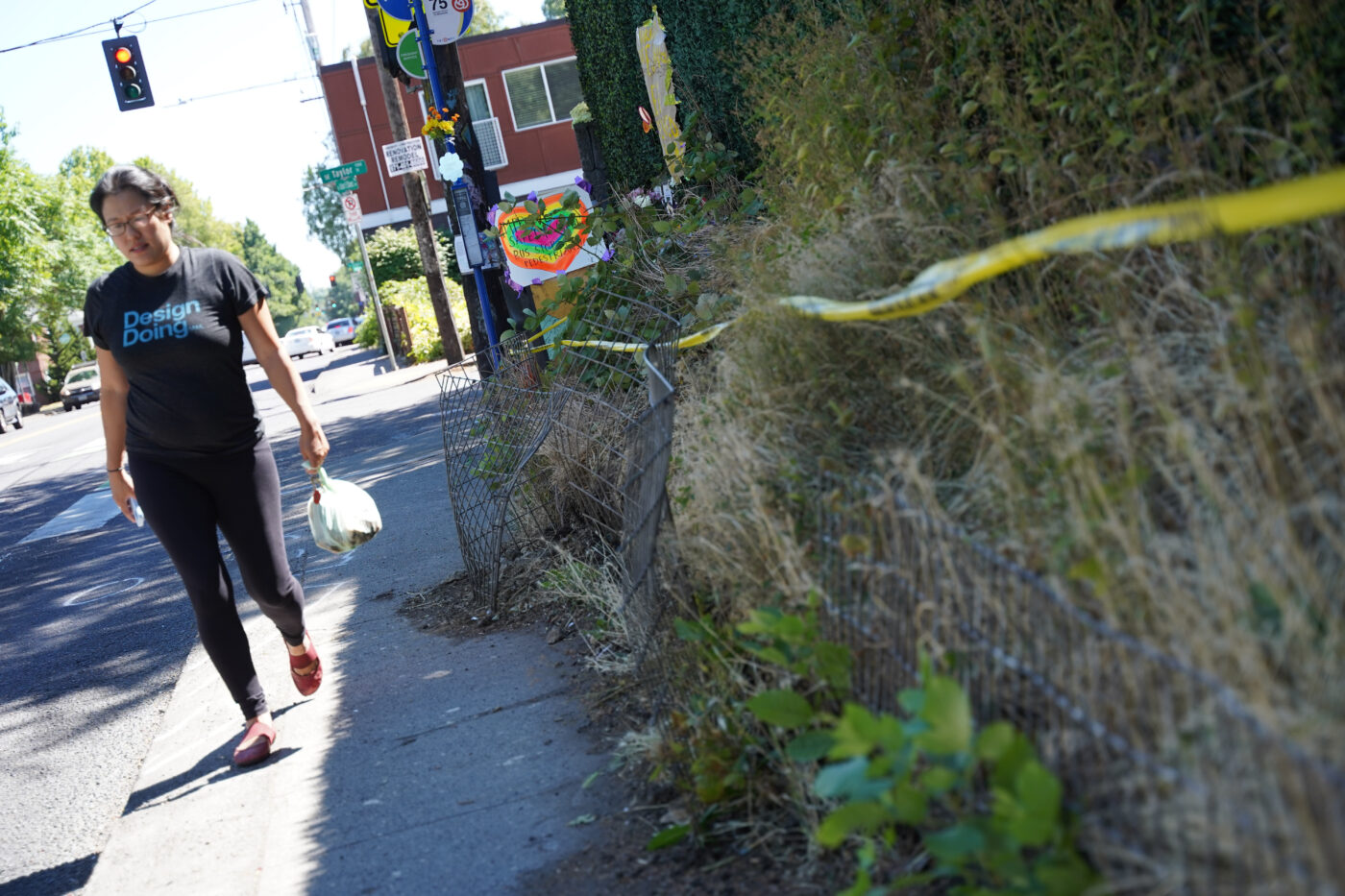
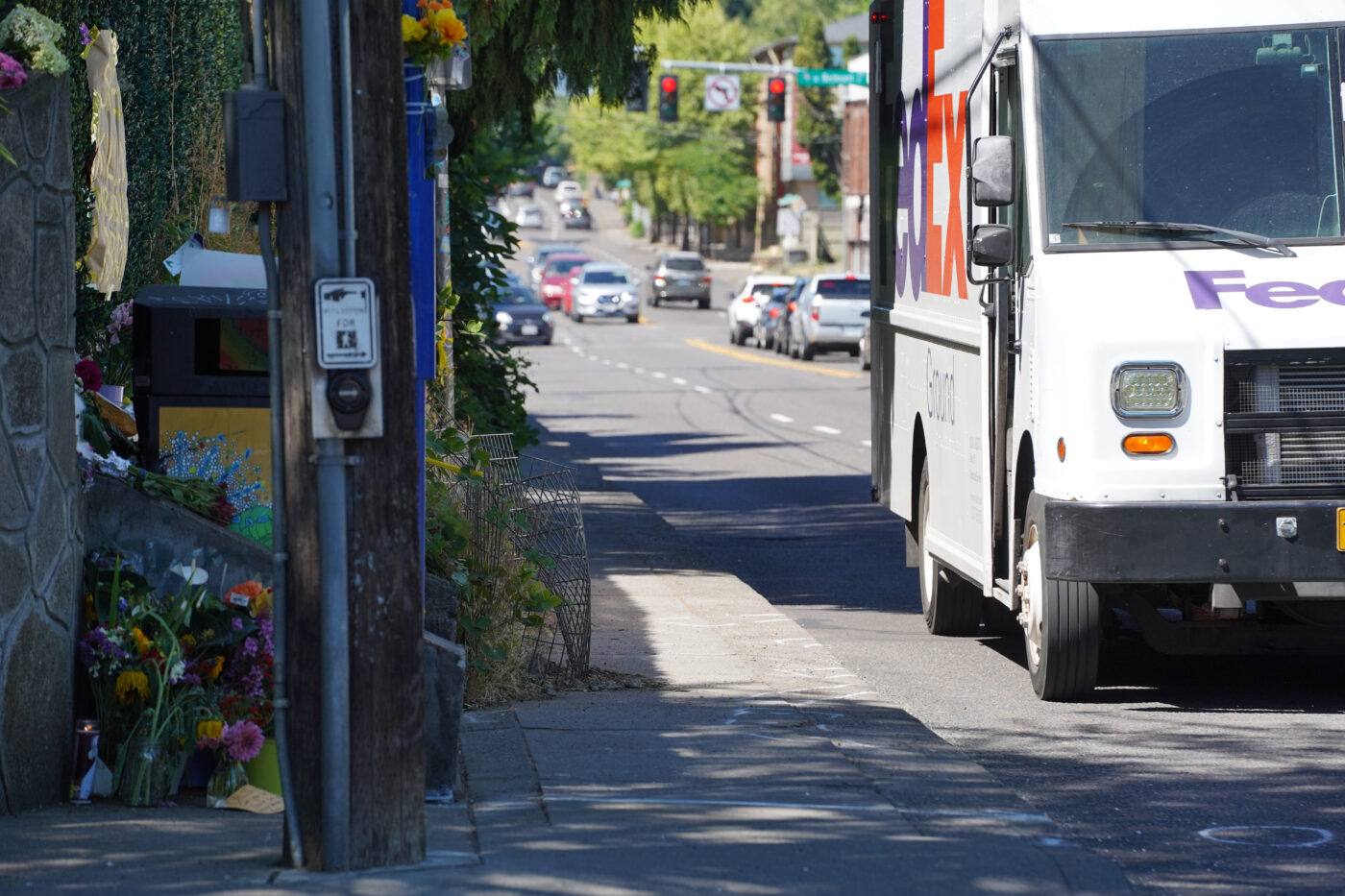

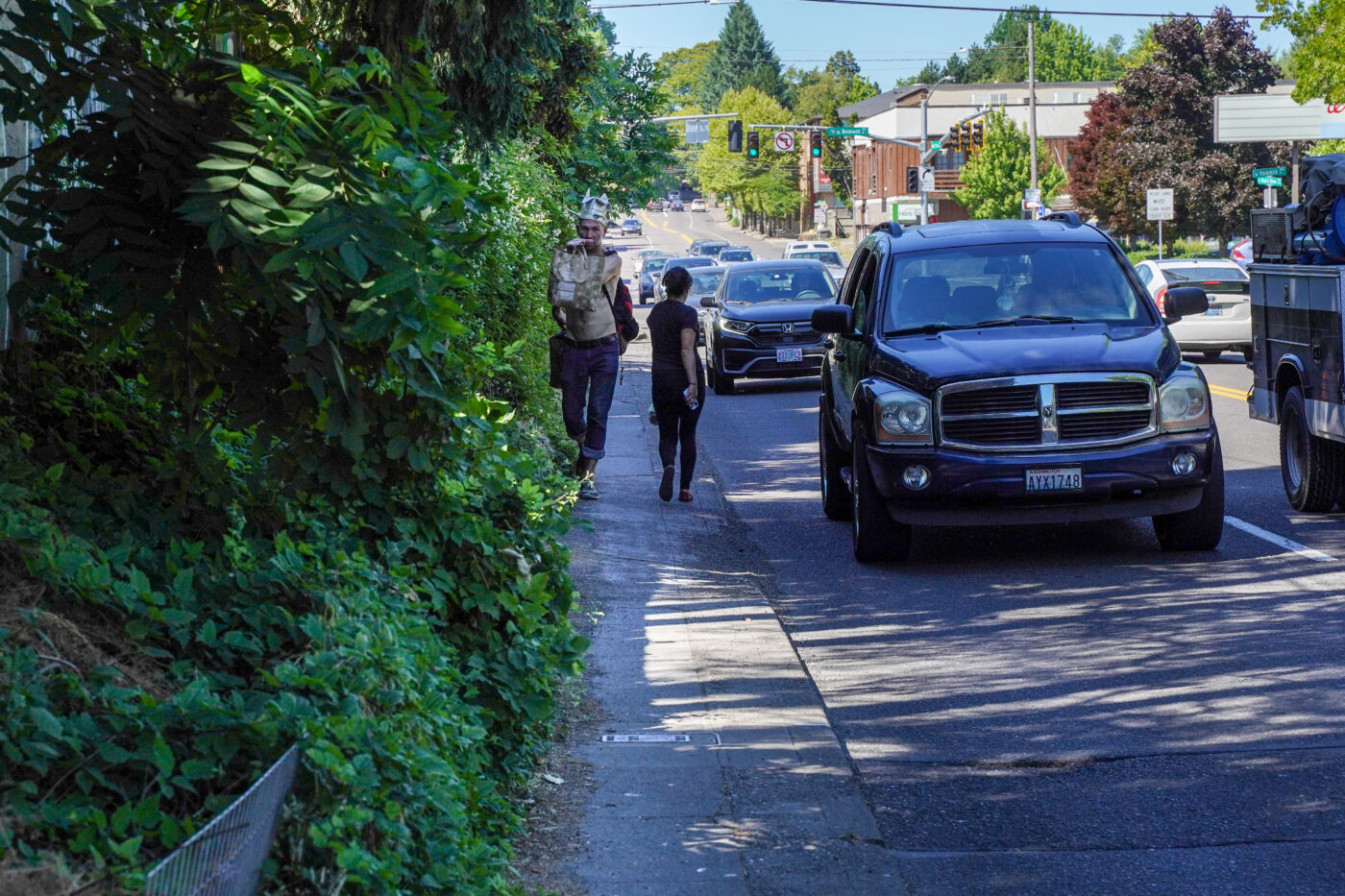

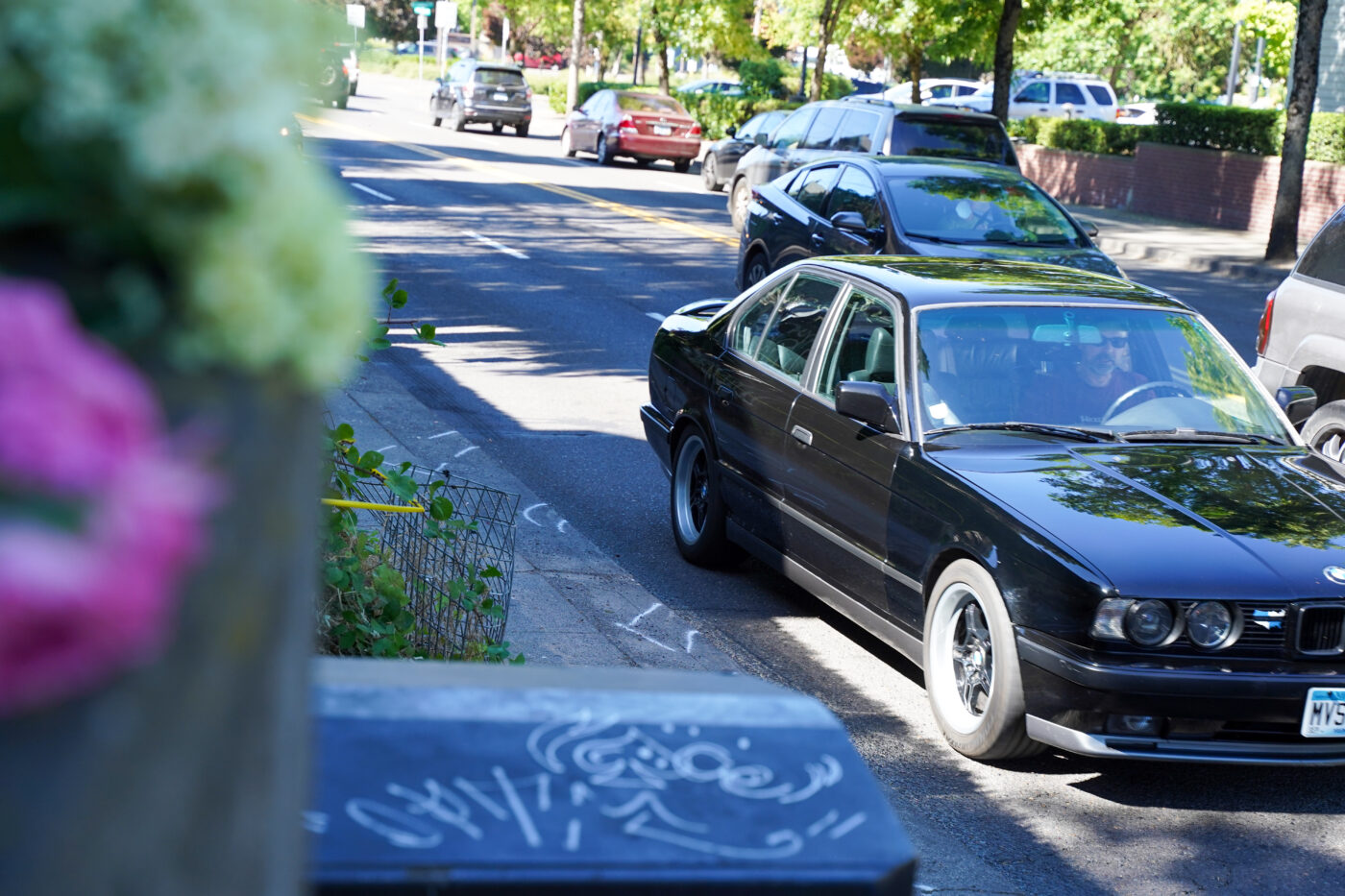
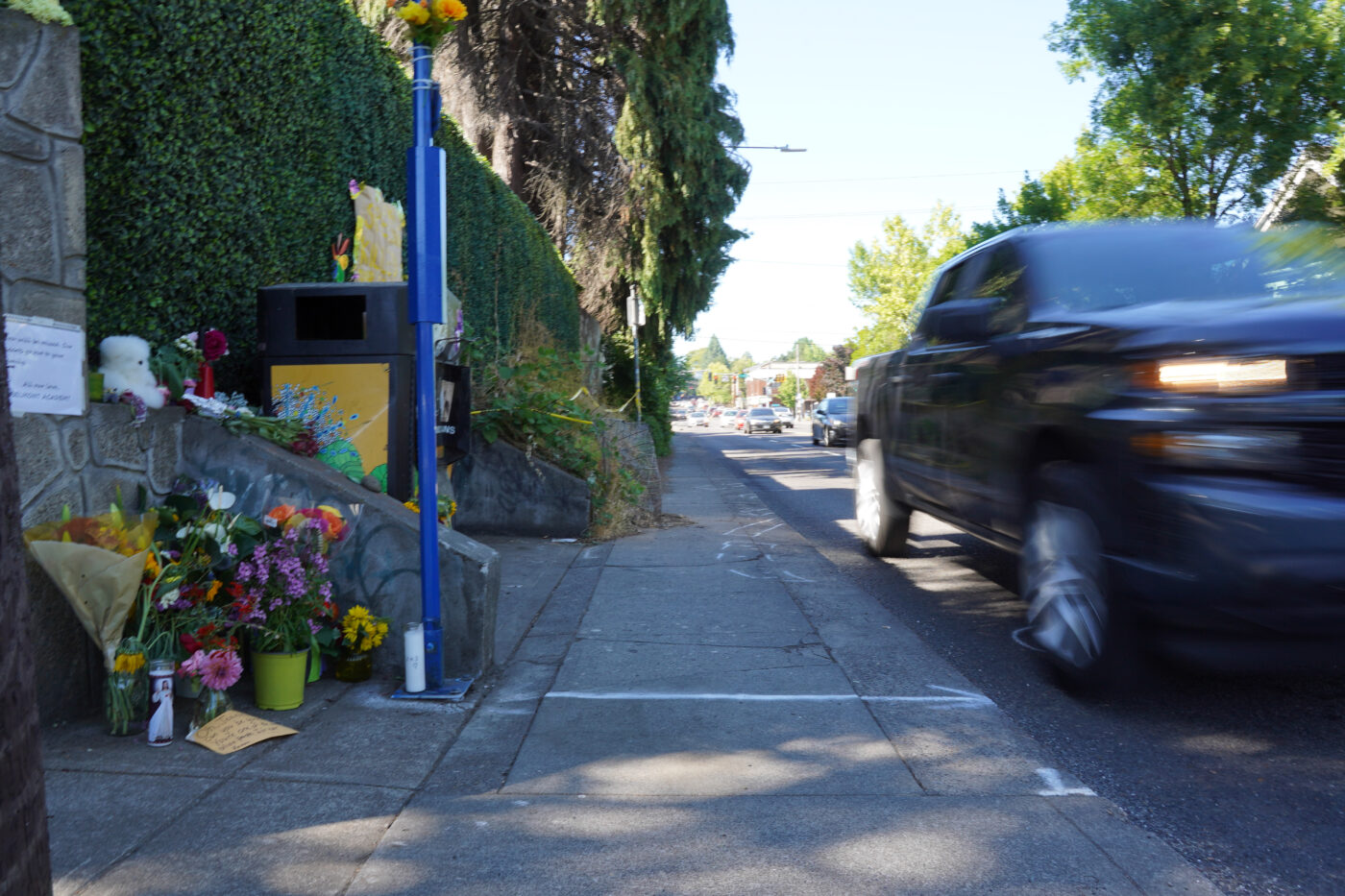


Diaz is the second person to be killed in less that one year by a speeding, reckless driver while waiting at a bus stop on a PBOT-owned street. She was the fifth person to die in a traffic crash in 10 days. We are trending toward even more deaths this year than last — despite our city’s dedication to Vision Zero. Our streets are increasingly feeling like a war zone where drivers are the occupying force and everyone else is made to run for cover and hope they don’t get caught in the crossfire.
The gap between the threat we face (drivers and their cars) and the mitigation we most often deploy (paint, plastic, and “pretty please!”) is where people are hurt and killed. Our tactics must change if we want to close that gap.
We talk a lot about protected bike lanes — PBOT has even tried to make them their default practice — but it’s time to extend that to sidewalks and bus stops. We need protected sidewalks at locations where there is no shoulder and where nothing separates a sidewalk from a lane of car traffic. We also need TriMet to consider protected bus stops. And I’m not talking about paint and plastic wands. It’s time to upgrade the artillery to steel bollards, guardrails, and/or concrete walls and barriers.
There is room for these and other changes on Cesar Chavez, like perhaps a road diet where we have three lanes instead of four, but it would mean reducing space for driving. Are local elected leaders up for doing that? Only if they care more about healing the heartache of our community and victims’ families more than facing potential political backlash.
PBOT is making solid progress with road diets and other projects citywide, but it’s not happening fast enough and their budget might not allow it to continue. In the shorter-term, while we work to increase enforcement (where are those promised photo cameras PBOT?), improve traffic culture, and fix the root causes of the overlapping social ills that lead to so much of this death and destruction, we must create more physical protection.
We must defend these spaces from the scourge of unsafe drivers.
Where Diaz was killed is either a neighborhood where people will feel like it’s safe enough to leave their houses on foot and bike — or it’s a highway where the only safe option is to get inside a car. As the deaths continue to tick upward, it’s becoming terrifyingly obvious that we cannot have both. The only question is, which one will we choose?





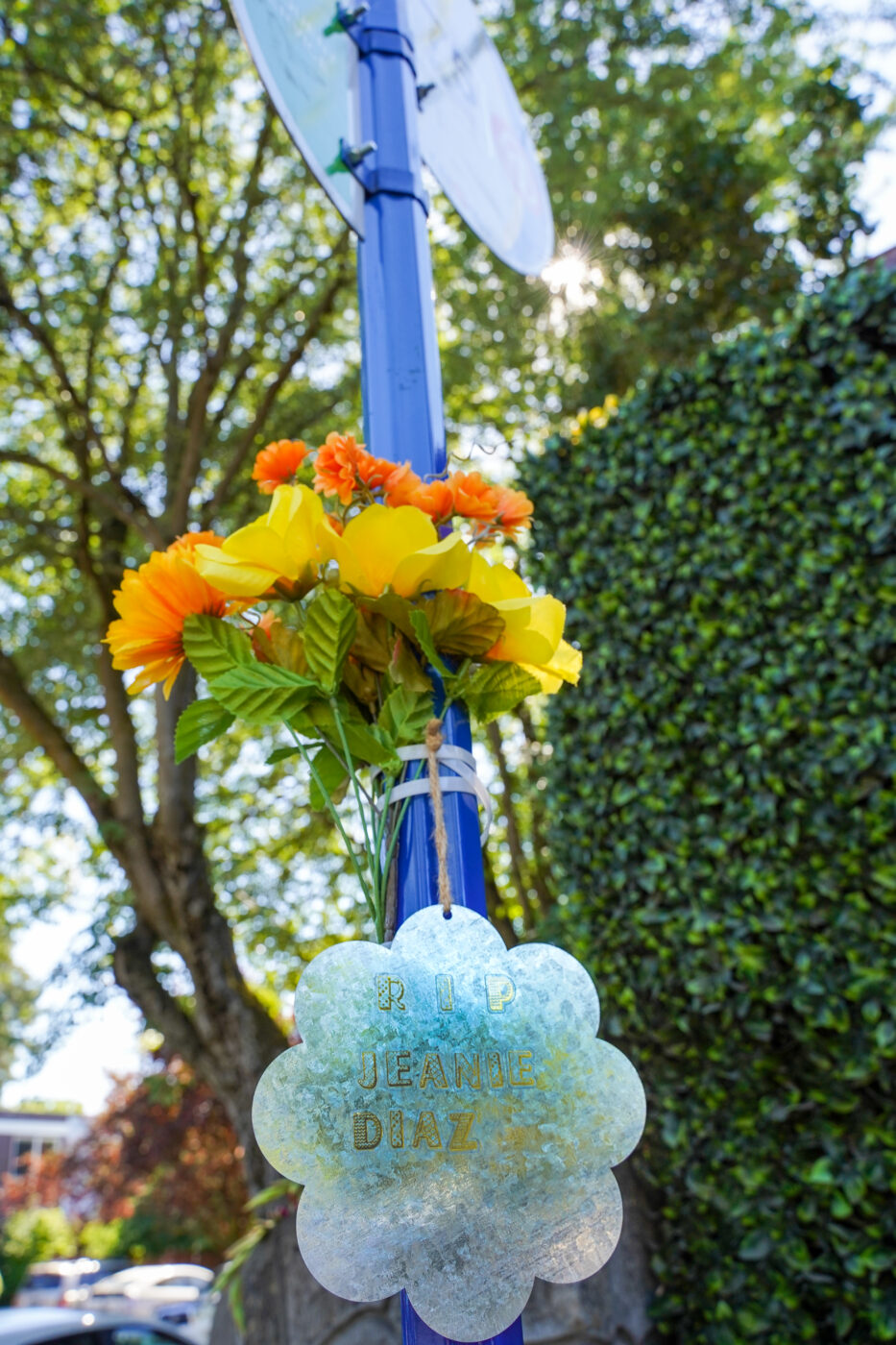
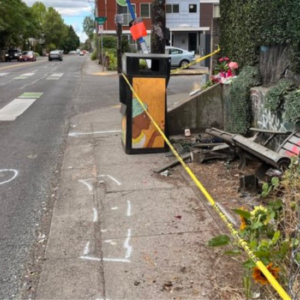

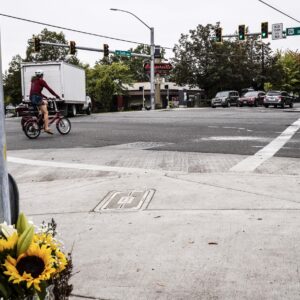

Thanks for reading.
BikePortland has served this community with independent community journalism since 2005. We rely on subscriptions from readers like you to survive. Your financial support is vital in keeping this valuable resource alive and well.
Please subscribe today to strengthen and expand our work.
She did deserve better. We all deserve it too. Can we honestly feel that this city at this time and place can deliver? I think of the worker at the Cascadia Mental Health center who was stabbed to death over the weekend or the dad that had his face knocked in and recovering from internal brain injuries for asking an open area drug user to not do so in-front of kids. We have a long ways to go and looking at city hall doesn’t breed any confidence at needle moving change. We instead are getting normal, every day people getting hit and killed by the effects of bad decisions that we all have to somehow deal with. If you haven’t looked elsewhere then I don’t know when you will.
Better enforcement by real cops needs to be a larger part of the solution. It’s the only one that can be implemented quickly and cover lots of Portland. And it seems to me that the crazier driving that we’ve seen recently in Portland may be due to the fact that there is less enforcement.
Additional cops and enforcement is NOT the solution for drivers. The solution is designing roads and spaces with the fact that some people will not adhere to traffic laws. One example is raised pedestrian crossings (like the ones at the Expo Center parking lot path from the train) that use physics to slow down a car at point at which it conflicts most with pedestrians. Physics works a lot better than a cop.
Raised crosswalks, speed bumps/tables, signaled crosswalks with median refuges, 4–>3 traffic calming, 20 mph speed limit, wider sidewalks (along with the policy changes I listed below).
F#$% more bike lanes!
The beginning of any kind of mode-shift away from cars relies on making this city safer to walk in (e.g. slowing homicidal drivers).
Raised pedestrian crossings will stop drunk drivers from killing people?
How do you stop drunk drivers without enforcement?
Didn’t this guy jump a 6″ curb?
Why do people here suggest that we coddle drunk drivers?
They need to be pulled over, taken off the road and never given a license to drive again.
Only enforcement can do that.
Yes, raised crossings will absolutely save lives, because of basic physics. Force=mass x acceleration
If you slow down the cars, you reduce the carnage, and you reduce fatalities. You can’t put up a sign and hope for the best, you need to design the roads around slowing cars down.
Designing a road around forgiving driver mistakes is an outdated mode of doing things. We should be designing a road around reducing conflicts before they start.
It’s a great sentiment. I also feel a visceral need to punish people like this.
The problem with your solution is it’s impossible to blanket the city with enough police to actually catch any but a fraction of the people who drive unsafely.
On the other hand, if you narrowed CC Blvd to 3 lanes, lined the new, much wider, sidewalks with barriers that can actually stop a car, changed the speed limit to 20mph then put in multiple speed radar spots and randomly moved your radar setup between them and ticketed anyone going over 29 MPH …..
Well, you’d hardly need the cops for that section.
Rinse and repeat.
It’s interesting that Helsinki (a city the same size as PDX) had so few traffic fatalities in 2022 that you can count them on 1 hand. We had that in a 10 day period, with Jeannie Diaz being the 5th.
When asked how they did it the basic answer was “we slowed cars down”.
Helsinki PD has more employees AFAICT – but I can’t tell if the sworn officers match the overall employee percentage difference (25%)
(and, yes, Finland is high on our list of places to live when we leave for safer pastures).
“On the other hand, if you narrowed CC Blvd to 3 lanes, lined the new, much wider, sidewalks with barriers that can actually stop a car, changed the speed limit to 20mph then put in multiple speed radar spots and randomly moved your radar setup between them and ticketed anyone going over 29 MPH …..”
Pigs might fly also some day….I think adding some enforcement is a lot more likely and possible than your scenario which will NEVER happen on 39th.
Yeah, but I don’t expect more enforcement either.
This is America, and we’re just gonna keep on killing people, because that’s who we are.
Every delay in changing design standards means more infrastructure precedents for the existing car culture. A few years ago we missed an opportunity when Sandy Boulevard was paved and restriped. It’s a major artery that parallels an adjacent high speed 3 lane limited access motor vehicle route. Nevertheless, the Sandy rebuild prioritized motor vehicle speed and capacity.
Sandy Boulevard was an opportunity to expedite transit and human scale modes while preserving SOV access at current levels in one lane with no significant time penalty. We blew it, and we’ll keep blowing it until we quit giving priority to the speed and convenience of private motor vehicle use on surface streets.
I have the greatest sympathy for Ms. Diaz’ family, friends, and neighbors. It’s a hard thing to say but under current policies, practices and infrastructure her death is treated as acceptable collateral damage. Defend that if you will.
Having or not having a license does not stop lots of drivers from driving; I’m gonna guess especially for distracted/intoxicated/reckless drivers.
We do not need enforcement AFTER a driver has assaulted someone. We need those assaults to be prevented. Why dream of punishment after someone has been killed or injured when you could dream of preventing the violence to begin with?
How do you stop drunk drivers without enforcement? We use physical barriers. That is preventative enforcement. Literally enforcing them to stay on the streets and not in pedestrian areas.
We do have some history of trying to build drunk-driver proof roads, and the result was very wide suburban streets. The truth is it’s hard to engineer against drunks, and the timescales for rebuilding arterials are very long.
Until we’ve rebuilt the streets, what should we do? Increase enforcement? Accept the death toll? Is there a third option for dealing with drunk drivers?
What we should do right now is update the city codes on how streets and roads are built and designed from the start, and every time a road is scheduled to be repaved, start implementing it.
Action right now is change the codes. That starts right now and doesn’t take time. It will be ~25 years from the time we change the codes before every road is repaved, but that is how Amsterdam achieved it’s safe cycling infrastructure with minimal public pushback.
I don’t disagree with you, but the question still stands. What do we do for the next 25 years?
The Pedestrian Design Guide came out a couple of years ago, and Streets 2035 is on its way: https://bikeportland.org/2021/10/12/streets-2035-and-pedestrian-design-guide-will-help-city-decide-who-gets-what-and-why-339712
We’ve done several articles on both. And I’ve got a whole series on how lack of stormwater infrastructure dictates inadequate active transportation facilities. It’s a big topic, but deaths get more eyes than policy.
Thank you, this is great to see. I moved here in 2022 and hadn’t heard about this
It’s not the plans we lack, but the will to stick to the priorities they embody when there isn’t enough for every car lane a traffic Engineer’s count might say is warranted (there will never be enough money or space for everything cars could possibly want.) And ultimately cars are an unreliable form of transportation which you can’t count on for anything better than 15-20mph because there’s too many cars. So we need to get over our science denialism and accept that Induced Demand is a real thing. You get the traffic you build for, and no more. Portland’s VMT has been flat because we have kept the same number of car lanes despite population growth. Our bike ridership is falling because we’ve let the bike network experience/conditions degrade. Pull on that lever, reduce VMT, and deaths will reduce proportionally (so will costs.)
Road diets don’t cost money, this is not some all-you-can-eat buffet fixed-price deal. Every mile driven costs us dearly in many ways, but very directly in pavement maintenance. No more four lane roads and quit letting every rando with a car have free-run through our bikeway network. Some people will have to drive around the block sometimes. PBOT’s Engineers need to reckon with the cost per mile driven and explain to politicians (and very clearly to the public) that there’s not a viable path to safety or a balanced budget by wishing cars would be nicer or cash-flow-positive. Geometry Hates Cars and Cars Ruin Cities — face facts or keep failing.
comment of the week
“The result was very wide suburban streets” because only the safety of drivers was considered, not the safety of pedestrians. Garbage in, garbage out.
I’m definitely in favor of right-sizing our streets and other safety measures. But they take a lot of capital and have a long lead time.
More enforcement by cops is much quicker at a larger cost over time.
I think we need both.
In January of 2022 PPD had the lowest staffing levels of the last 20 years. This wasn’t because of budget cuts (the cuts for the 2020-2021 FY were all of vacant positions (45) and left dozens of still vacant positions unfilled – from their 2022-2023 budget request)
Even though I’m no PPD apologist, I think expecting them to actually ramp up enforcement is unrealistic – even with a dramatically increased budget for 2022-2023 over past years they are still struggling to fill those vacant positions.
As a result, I’m not sure more enforcement is actually quicker.
I’m not sure there is a *quick* answer. In fact, we (Portland specifically and America in general) are completely incapable of dealing with this on a very basic level.
Americans don’t care enough about other people to be even *slightly* inconvenienced in the name of protecting their neighbor’s lives.
My answer is still 8 years out – pack up and leave.
Sure…maybe that too.
The natural conclusion to America’s “rugged individualism”/”I got mine #$%& y’all” founding principle.
I’m in agreement – the answer is escape.
When all you have is a hammer, everything looks like a nail? In this case the hammer is explicitly unwilling. In the past week I had a conversation with a PPD officer who told me that they were exercising discretion not to ticket a driver who departed from a stop sign and ran into a vulnerable road user traveling with the right of way. I witnessed this from a block away and the facts were not in dispute.
The cops we have don’t want to participate. Are there some other cops out there that can help?
Multnomah County sheriff’s dept?
Yeah, drunk drivers do what they want no matter the infrastructure. Lack of infrastructure played a role but drunk boy knowing that he probably wasn’t going to get pulled over also did. This infrastructure only crowd won’t win too many people with some enforcement along with it. I hope you don’t think people don’t speed along Division now….
The cops we have are really expensive, I bet “real” cops would cost even more. Hard infrastructure has up front costs, but then it works 24/7 with comparably low maintenance costs.
While I could imagine a bunch of cops doing something more quickly than PBOT fixing roads, the timeline for cops agreeing to do traffic enforcement consistently, fairly and effectively seems to be eternally on the horizon.
Protected sidewalks?
It’s ridiculous that someone would call for for expensive concrete walls instead of demanding that we implement proven policie that would prevent our neighbors from killing people with their hulking GHG-spewing machines. Strict liability, lower blood alcohol limits, harsh legal penalties for reckless/drunk driving (including permanent loss of driving rights), mandatory driver training/re-testing, taxes on vehicle weight/size, intelligent speed assistance, pedestrian detection with automated braking are all standard policy in European nations.
The CARnage in this society is a choice. American culture is a homicidal death cult.
pierre delecto,
I want all that stuff too.
With all due respect, the idea that we need to build concrete walls/barriers that further divide our neighborhoods to protect ourselves from drivers is such an american response to traffic violence. Highway-like barriers may protect people midblock but they would also encourage drivers to speed which would likely increase risk at intersections.
We have a very American problem, so I feel that an American response is needed. And you’re focusing too much on my remedies here. This is an opinion piece where I’m saying we need to protect people better. I’m not laying out a detailed design solution… I’m just trying to get people thinking and say that I feel we have to meet fire with fire.
I totally disagree with you that European solutions would help here. And all the legislative/policy fixes you mentioned in your previous comment are nice, but they’d be big lifts and could take years. I think, given the imminent threat out there and the fear people are feeling, we should/could get some barriers or other type of strong protective element out onto the streets in the short term.
The people who need to provide the solution work at PBOT, ODOT, Trimet, and Metro.
That honestly sounds scary. Who do you think got us to this point? They created the mess so now they have the experience to fix it? I can’t help but laugh.
Do you really see installing concrete barriers along streets like this one as a short-term solution?
It’s what PBOT did for us on a section of Broadway, the Michelle Marx Pedestrian Path: https://bikeportland.org/2022/04/15/sw-infrastructure-update-broadway-dr-red-electric-bridge-capitol-hwy-352184
Sometimes a road is so dangerous you need to do whatever you can, fast.
This “short-term” solution was, of course, rapidly installed for Portland’s 500 mile network of protected bike lanes.
Allow me to introduce the humble bollard:
Put that on 39th and everyone will have to walk sideways.
That’s why you put the bollards in the street, not on the sidewalk.
Yep – we have to take back space from cars in order to protect people. It’s pretty simple.
Four-lane stroads running through urban areas should be banned.
I didn’t realize it was that simple!
Nothing is simple in this city.
I never said it was simple. You said that if we protected the sidewalk with Bollards, people would have to walk sideways. I answered you, that is why you put the bollards in the street. Don’t put words in my mouth.
I said that in response to someone posting a photo of bollards on a sidewalk. Putting bollards in the street, as you suggested, cannot work for a number of reasons, including the lack of space (unless you reduce the number of lanes, which is an entire project unto itself, and would then allow you to put them on the sidewalk), and, more importantly, the fact that no engineer would ever sign off on it.
So yes, sure, putting bollards in the street would solve the sidewalk space problem. It’s just impossible in any practical sense.
Actually, you could put in orange traffic cones and call it a work zone, and it would work even better – engineers regularly sign off on them and they are really cheap and effective. A “pop-up bollard” if there ever was one.
Behold, bollards installed directly in the street in lieu of a raised curb. Approved by an engineer and everything.
That’s one of my favorite uses of bollards in Portland–replacing the curb as you said, which along with running the plaza paving all the way over the street to the far curb gives a real pedestrian-centered feeling, even though cars are still allowed on the street.
It’s so much better than most of the street design work downtown. And I don’t think it’s a coincidence that these bollards and the paving were almost certainly designed by the square designers, and not PBOT.
It’s a great example of bollards, which was your point, but also illustrates how much better street design can be when done by people who design urban spaces rather than by transportation engineers.
Seeing this reminded me of the recent article about the homeowner on SE Woodstock who applied for a permit from PBOT to install bollards in the parking strip because their house had been repeatedly hit by cars, and were denied permission.
PBOT not giving someone in that case permission to install bollards at their own expense may be a clue as to how likely PBOT is to install bollards–at PBOT’s expense–on streets like this.
I would’ve just installed them which is what we do in Southeast.
I don’t know why bollards were not approved in that specific location. But here are PBOT-installed steel bollards along Naito Parkway, even before the construction of Better Naito. They’re also used at assorted intersections downtown. Whether similar treatments get used elsewhere seems like a question of having the right funding, leadership, and public pressure. Daunting obstacles to be sure, but not impossible.
Agreed, however I doubt PBOT stopped consideration at the first glance of cost.
Other factors to consider, in no particular order, include but are not limited to:
-Precedent. Allow one to do it and others will want/expect/demand the same.
-Continued expense. Who is responsible for maintaining or replacing the bollards? Are they willing to pay to find out through legal settlement from an insurance company that disagrees with PBOT allowing a private party to modify the public roadway after their client failed to turn, or collided with one during an alleged maneuver to avoid a potentially worse collision?
-Perceived responsibility. One cannot assume that anyone looking at the privately funded bollards would understand PBOT was not responsible for their installation, even if they were labelled accordingly. Again others would see them, and demand the same treatment.
-Perceived shame/dissolution of trust. It is reasonable to assume that PBOT believes there are people that have trust and faith in what PBOT does, the allowance could make them “look bad” and (further) erode that trust, which could in turn complicate petitions to improve their(PBOTs) financial situation.
Would making an allowance be worth making any or several of these bets? I loathe that PBOT appears to fall short in many simple ways, but I also know that my perception is inherently limited and that while they lack transparency, providing that requires additional (should be mandatory) work. Are the wands they insist on putting up preferred to bollards because of the potential need for emergency vehicles to ignore and consequently drive over them? Or is just cost of material and time to install bollards that are capable of stopping a vehicle?
I’m sure you’re right, especially that PBOT didn’t want to set precedent with an approval. My response is–PBOT should have approved the bollards, and told people it IS a precedent–PBOT will approve bollards in front of any house that’s been hit by cars.
Of course what PBOT really should have done was to include substantial barriers–not just low curbs–in its design.
Does “parking strip” mean the grassy space behind the curb? Because if it were an actual parking space a person could park a junker in there, drive it around the block every 72 hours, and scrub it once a month to keep the lichen down.
If it’s the grassy area, maybe grade it with a slope to launch the errant vehicle into some shrubbery? It wouldn’t be any worse for the occupant(s) and perhaps better.
See also: brutalist architecture.
All of these things are a tax on the home owner for living in a dangerous place. It should be the reverse! If I were there I’d probably be building the berm right now, a lot of the cost would be labor and I like that sort of thing.
Yes, that’s what I meant by parking strip.
You’re right about if it were a parking space–a vehicle parked in it would serve as a barricade. The irony is that as I recall, there USED to be a parking space there, meaning any time there was a vehicle there the house was safer–but PBOT replaced that space with a low curb and paint. So the owner no longer can do what you suggested, but could have before.
I agree, if I lived there, I’d be thinking like you–adding a berm or something similar.
Let’s spend tens of millions installing steel bollards along the entire length of Chavez* instead of implementing far, far less expensive infrastructure (and policy) designed to slow drivers. Your vision is a form of defeatism that avoids any challenge of violent car culture (and will never happen, because “fixing potholes” and maintaining speed is prioritized in our car culture ).
* that would allow drivers to continue to speed through intersections — the locations where the majority of pedestrians are brutally killed.
“Raised crosswalks, speed bumps/tables, signaled crosswalks with median refuges [and] wider sidewalks” are way more expensive than steel bollards. These entail more or less a complete street reconstruction, especially when you have to move storm drains.
I agree with you that all the above are essential tools to make streets safer for pedestrians in the long term. Mentioning bollards was intended as a half-joking response to your comments about “expensive concrete walls” and “highway-like barriers”, to point out that there are a number of immediate options, as Jonathan also mentioned. It’s not an either-or proposition.
But I guess since my “vision” will never happen, neither will yours. So what are we all doing here?
(As an aside, I think Jonathan was talking about moveable concrete “Jersey barriers” more than a permanent wall. Heck, even plastic ones filled with water or sand would be better than nothing.)
While you say people go 35 mph on this stretch, and that is true, I feel some further context is needed: The speed limit here is 30 mph. And it’s common to see people going 40 mph or worse.
Chavez needs to be signed and enforced at 25 mph for its full length (it drops to this speed limit only south of Holgate), and where it’s currently four lanes, it needs a road diet down to two travel lanes and a center turn lane. Gonna need some intermittent medians too, to prevent people from using the center turn lane as a passing lane (as in the murder of Fallon Smart), of course.
This one hurts really badly. There are no words to describe the loss, and no words harsh enough to indict PBOT inaction on Vision Zero. Zero means none PBOT – not just a few more while we kick the can down the road.
Well said Jonathan. It is disgusting that of the 79 people killed by motorists in Portland last year only 21 were in cars. That’s a ratio of nearly 4:1. Where is the outrage? Where is the sense of urgency?
This death is the result of PBOT negligence. This road should not exist in its current form. A right-of-way needs adequate pedestrian facilities to be established first, then use the rest for bikes, transit, freight and cars. I would not trust PBOT to “address” this issue, however. The current group of engineers there are so car focused they have been relying on closing sidewalks and crosswalk to address deficiencies instead of actually making them work. I predict a PBOT solution will be to detour pedestrian on toa parallel street, and move bus stops to cross-streets.
An absolute tragedy.
I hope they throw the book at this guy. To add insult to injury, Kevin Scott’s LinkedIn profile includes nine endorsements for his “risk management” skills.
They did. He faces some serious charges.
Only b/c he was drunk. If he had not been drunk, he would have gotten a ticket for leaving the lane of travel and he’d be out there driving again today.
Yep. If you choke on a soda you can kill without recourse.
https://bikeportland.org/2015/06/15/enough-enough-another-death-must-spur-real-action-144397
Douglas Walker choked on a soda and killed a man.
Out on $5000 bail already. Probably already driving around drunk.
When injuries and fatalities continue to increase that is a clear sign that our safety policies have failed. Infrastructure improvement is needed, but it is slow and unequally distributed. A state law requiring speed governors on all cars installed at the time of vehicle registration would quickly eliminate speeding, which is the underlying cause of every motor vehicle crash.
I daresay each and every one of the dozen people killed so far this year while walking on Portland streets deserved better than this (and the 28 pedestrians killed last year, and the 27 the year before that, etc. etc. ad infinitum):
https://bikeportland.org/fatality-tracker
It’s always easier to get the media to pay attention when a young, white (or white-passing) woman dies. I can only hope this incident will make our so-called leaders go beyond the typical thoughts-and-prayers approach of just asking very politely for people to not drunkenly climb behind the wheel of a two-ton metal death machine, but I fear many more people will succumb to vehicular violence before that happens.
“It’s always easier to get the media to pay attention when a young, white (or white-passing) woman dies.”
You actually went to some weird kind of race issue here,,, Get Help.
“Missing white woman syndrome” is a well-documented media phenomenon. Ignoring facts doesn’t make them go away.
https://en.wikipedia.org/wiki/Missing_white_woman_syndrome
Considering how much attention is focused on this one homicide and not on the dozen other pedestrian deaths this year, perhaps there is some validity to the idea that race and/or class influences the attention our society pay to violence (traffic violence).
Or maybe it was a young mother with 2 young children killed out of the blue… It never occurred to me to even see what race she was, I had no idea as it doesn’t matter to me or to normal people.
yes. Race and class play a role in how much attention we pay to a traffic death… But so do many many other factors. There is so much that comes into play. In this particular case, I don’t think race/class are why it’s getting a lot of attention.
I don’t think race can be entirely dismissed as a factor. César E. Chávez Blvd. is listed as a High Crash Network Street with a *high number of pedestrian crashes*. Yet as you say, many people assume the area is “safe”. Is it just a coincidence that this presumably “safe” area is located in the inner, whiter part of Portland?
https://www.portland.gov/transportation/vision-zero/high-crash-network
Are you saying that racial bias is causing people to overlook and downplay the true dangers of this street?
I believe it could be a factor, yes.
My first question is, was that bus stop legal to start with? Did it conform to the standards for a bus stop in Portland? Can you imagine if a family was waiting for a bus, a baby stroller, a person in a wheelchair? And how do we make sure that the bus stop is moved to a safer corner, because this corner does not look safe.
We need to make the street safe first. Then the bus stop will be safe.
We do not need to accept the stroad status quo.
I don’t believe any white person is at risk of getting a DUI in Portland unless they are involved in a serious accident. Drinking and driving is basically legal.
That’s PBOT’s version of “thoughts and prayers.”
I think it’s clear that while community members may have demands from PBOT, they are bound by the very stretched dollar. That why when items like this happen, I can’t help but look at wasted money in other areas because it feels like PBOT wants to pay themselves on the back when they add speed cushions with emergency vehicle cutouts. They seem to miss the idea that the larger vehicles don’t have to respect the cushion and drive right through. This matters because you are 3-4x likely to die from being hit by a larger vehicle than a Prius. Anywho, I think the expectation and bar is set too high for PBOT alone to change the course of action, resources from other places (not random orange barrels) will need to be deployed.
I would suggest people call and demand a PBOT statement and cost to fix Cesar Chavez. You can try 311 but that will not work.
Call (503) 865-6089
Demetri.finchBrown@portlandoregon.gov
I asked for a statement by PBOT about the death of Jeanie. PBOT said they don’t know who would issue a formal statement. PBOT staff Demetri ended the call abruptly saying I was being augmentative.
Below is a quote from the PBOT 2016 statement about the death of Fallon Smart that I shared with Demetri. This statement was made twice. I was not making an argument, I wanted my current request to include the pattern of the past that I do not find acceptable. This statement was made once in the Oregonian newspaper and again at a PBOT town hall I attended. ( Jeanie Diaz and Fallon Smart and Austin Gary Boyd are all pedestrians mowed down a few blocks apart in SE Portland recently )
Better than a yard sign or puns:
Immediately take away one or two lanes of traffic from Cesar Chavez from I-84 to where it narrows by Holgate for one month with jersey barriers and street closed signs (as if it is under construction like PBOT does all the time.) The lanes can be used for bus rapid transit and everyone’s favorite pearl to clutch “emergency vehicles.”
After one month, 99% of drivers have to drive the posted speed limit +/- 5 mph for one week to have the lane reopened. After the lane is reopened, if speeding returns or if there is a car collision related to speed, close the lanes again for one month.
You’re welcome, PBOT.
Collective punishment. I love it!
Not punishment.
Rehabilitation. Education. Awareness.
Each trip driven on Chavez now comes with a moment of silence built in.
However, instead of the moment of silence coming after someone is killed, it is done to prevent the next tragedy.
Has PBOT issued a statement about this? This is the road network Millicent Williams is inheriting, I would be very interested to hear what she has to say about this
In my lifetime experience and observations:
It’s time to stop ceding so much urban space to the automobile. Take back the space.
Taller 12″ curbs = vehicles less likely to “accidentally” jump the curb.
Give PBOT the authority to operate mobile speed photo radar vans. Ticket everyone going 6 over instead of 11 or more over.
Take the revenue and fill in PBOTs budget gap.
With the way people drive today in Portland, PBOT will have its biggest budget ever!